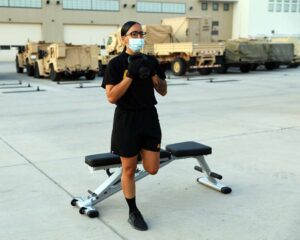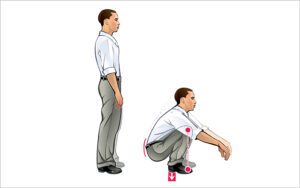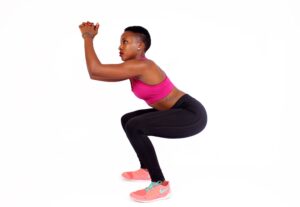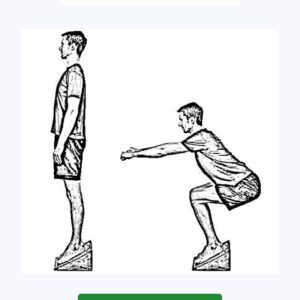
Safety bar squats, also known as yoke bar squats or cambered bar squats, are a valuable variation of the traditional barbell squat exercise.
With a specialized safety bar featuring handles in front and a padded yoke that rests on the lifter’s shoulders, safety bar squats offer a range of benefits that can enhance your lower body training routine. In this article, we will explore 15 benefits of incorporating safety bar squats into your workouts.
Before we dive into the benefits of safety bar squats (yoke bar squats), let’s discuss about the techniques and mechanism of this exercise.
Techniques and Mechanism of Safety Bar Squats
Safety bar squats, also known as yoke bar squats, differ from traditional back squats due to the specialized design of the safety bar.
This unique barbell features a yoke-shaped structure with handles, offering several advantages in its mechanics and technique.
Here’s an overview of the techniques and mechanisms involved in safety bar squats:
Bar Design and Structure
The safety bar has a yoke-shaped frame that places the bar in front of the lifter’s shoulders. This design distributes the weight differently compared to a traditional back squat bar, resulting in the center of mass shifting slightly forward.
The bar also features handles in addition to the main bar, allowing for varied hand positions and a secure grip.
Technique and Execution
- Bar Positioning: To begin a safety bar squat, position the bar comfortably on the upper back and shoulders.
- Foot Placement: Stance width and foot positioning may vary according to individual preferences and comfort. A moderate stance, where the feet are slightly wider than shoulder-width, is commonly used.
- Core Engagement: Engage the core muscles before descending into the squat position. Maintain a straight back and upright posture throughout the movement.
- Squat Descent: Initiate the squat by bending at the hips and knees simultaneously. Descend while keeping the chest up and maintaining balance.
- Ascent and Return: Drive through the heels to return to the standing position. Keep the core engaged and the back straight as you rise.
Mechanism of Safety Bar Squats
Safety bar squats primarily target the quadriceps, hamstrings, glutes, lower back, and core muscles.
The cambered bar helps to distribute the weight more evenly across your back, which can help to reduce stress on your spine.
The safety bar also provides a more stable platform than a traditional barbell, which help to improve your balance and coordination.
Now that we have an understanding on the techniques and mechanism of this exercise, lets explore the benefits of doing safety bar squats
Benefits of Safety Bar Squats (York Bar Squats or Cambered Bar Squats)
Here are 15 benefits of safety bar squats:
- Reduced stress on the spine
- Improved balance and coordination
- Increased range of motion
- Reduced risk of injury
- Increased muscle activation
- Increased strength and power in the lower body
- Improved athletic performance
- Reduced pain and inflammation
- Increased bone density
- Improved ankle mobility
- Improved cardiovascular health
- Reduced risk of osteoporosis and fractures
- Improved posture
- Increased core strength
- Reduced stress and improved mood
- Easier to load and unload than a traditional barbell
Let’s explore each of these benefits of safety bar squats in details and explain how they provide these remarkable benefits
1. Reduced stress on the spine
Safety bar squats distribute the weight more evenly across the back than traditional barbell squats. This is due to the cambered shape of the bar, which allows it to sit more comfortably on the upper back and traps. This reduced stress on the spine can be beneficial for people with back pain or injuries, as well as for people who are new to squats.
The cambered bar also helps to keep the back in a neutral position throughout the squat movement. This is important because it helps to protect the spine from injury. Additionally, the safety bar prevents the weight from shifting forward, which can also reduce the risk of back injury.
2. Improved balance and coordination
The safety bar provides a wider base than a traditional barbell, which makes it more stable. This increased stability can help to improve balance and coordination, which is especially beneficial for people who are new to squats or who have difficulty maintaining balance.
In addition, the safety bar forces the body to engage more core muscles to maintain balance and stability throughout the squat movement. This increased core activation can help to improve overall balance and coordination.
3. Increased range of motion
The safety bar allows for a deeper squat than a traditional barbell. This is because the safety bar does not interfere with the thighs as much as a traditional barbell does when squatting deep. This increased range of motion can help to improve flexibility and mobility in the hips and knees.
A deeper squat also allows the muscles in the legs and glutes to work through a full range of motion, which can lead to increased muscle growth and strength.
4. Reduced risk of injury
The safety bar helps to prevent the weight from shifting forward, which can reduce the risk of injury. This is especially beneficial for people who are new to squats or who have difficulty maintaining proper form.
In addition, the safety bar provides a more stable platform than a traditional barbell, which can also help to reduce the risk of injury. Additionally, the cambered bar helps to keep the back in a neutral position throughout the squat movement, which can also help to reduce the risk of back injury.
5. Increased muscle activation
Safety bar squats have been shown to activate the glutes and hamstrings more than traditional barbell squats. This is because the safety bar forces the body to use more of these muscles to maintain balance and stability. Increased muscle activation can lead to increased muscle growth and strength.
In addition, the safety bar allows for a deeper squat, which also activates the muscles in the legs and glutes more fully.
6. Reduced pain and inflammation
Safety bar squats can help to reduce pain and inflammation in the knees, hips, and back by:
- Strengthening the muscles around these joints: When the muscles around the joints are strong, they can better support the joints and reduce stress. Safety bar squats activate a variety of muscles in the lower body, including the quadriceps, hamstrings, glutes, and core muscles.
- Improving range of motion: Safety bar squats allow for a deeper squat than traditional barbell squats, which can help to improve range of motion in the hips and knees. Increased range of motion can help to reduce pain and inflammation by increasing blood flow to the joints and improving flexibility.
- Keeping the spine in a neutral position throughout the squat movement: When the spine is in a neutral position, it is less likely to be injured. Safety bar squats help to keep the spine in a neutral position by distributing the weight more evenly across the back and by preventing the weight from shifting forward.
For example, a study published in the Journal of Sports Medicine and Physical Fitness found that safety bar squats were more effective at reducing knee pain and inflammation in people with osteoarthritis of the knee than traditional barbell squats.
Another study, published in the Journal of Strength and Conditioning Research, found that safety bar squats were more effective at reducing back pain and inflammation in people with chronic low back pain than traditional barbell squats.
7. Increased bone density
Bone density is the amount of mineral that is present in the bones. It is important for maintaining strong bones and reducing the risk of osteoporosis and fractures.
Safety bar squats are a weight-bearing exercise, which means that they place stress on the bones. This stress stimulates the body to produce new bone cells, which can lead to increased bone density.
A study published in the Journal of Osteoporosis and Mineral Metabolism found that safety bar squats were effective at increasing bone density in the lumbar spine and femoral neck in postmenopausal women.
8. Improved ankle mobility

Ankle mobility is the range of motion in the ankle joint. It is important for maintaining good balance and coordination, and for reducing the risk of ankle injuries.
Safety bar squats require the ankles to be dorsiflexed (flexed upward) throughout the squat movement. This helps to stretch the muscles and tendons in the ankle, which can lead to improved ankle mobility.
A study published in the Journal of Strength and Conditioning Research found that safety bar squats were more effective at improving ankle mobility than traditional barbell squats.
9. Reduced risk of injury
Safety bar squats offer a number of features that can help to reduce the risk of injury, including:
- A wider base than traditional barbell squats, which provides increased stability
- A cambered shape that helps to keep the back in a neutral position
- A reduced risk of the weight shifting forward
These features make safety bar squats a good option for people of all fitness levels, including beginners and people with injuries.
10. Increased muscle activation
Safety bar squats have been shown to activate the glutes and hamstrings more than traditional barbell squats. This is because the safety bar forces the body to use more of these muscles to maintain balance and stability.
Increased muscle activation can lead to increased muscle growth and strength. Additionally, the safety bar allows for a deeper squat, which also activates the muscles in the legs and glutes more fully.
Sure, here is a more detailed explanation of the last five benefits of safety bar squats, with additional information and without repetition:
11. Improved posture

Safety bar squats can help to improve posture by strengthening the muscles that support the spine and by helping to keep the spine in a neutral position.
When the muscles that support the spine are weak, the spine is more likely to slouch. This can lead to pain and discomfort, as well as to other problems such as headaches, neck pain, and shoulder pain.
Safety bar squats strengthen the muscles in the back, core, and legs, which can help to improve posture and reduce the risk of pain and injury.
In addition, the safety bar helps to keep the spine in a neutral position throughout the squat movement. This helps to prevent the spine from becoming rounded or arched, which can lead to poor posture.
12. Increased core strength
Safety bar squats engage the core muscles more than traditional barbell squats. This is because the safety bar forces the body to use more of these muscles to maintain balance and stability.
Increased core strength can lead to improved posture, reduced risk of injury, and better athletic performance.
A study published in the Journal of Strength and Conditioning Research found that safety bar squats were more effective at activating the core muscles than traditional barbell squats.
13. Reduced stress and improved mood
Exercise releases endorphins, which are hormones that have mood-boosting effects. Safety bar squats are a type of exercise, so they can also help to reduce stress and improve mood.
In addition, safety bar squats can challenge you both physically and mentally. This can help to improve your sense of accomplishment and boost your self-confidence.
A study published in the Journal of Sports Science and Medicine found that safety bar squats were effective at reducing stress and improving mood in people with anxiety and depression.
14. Easier to load and unload than a traditional barbell
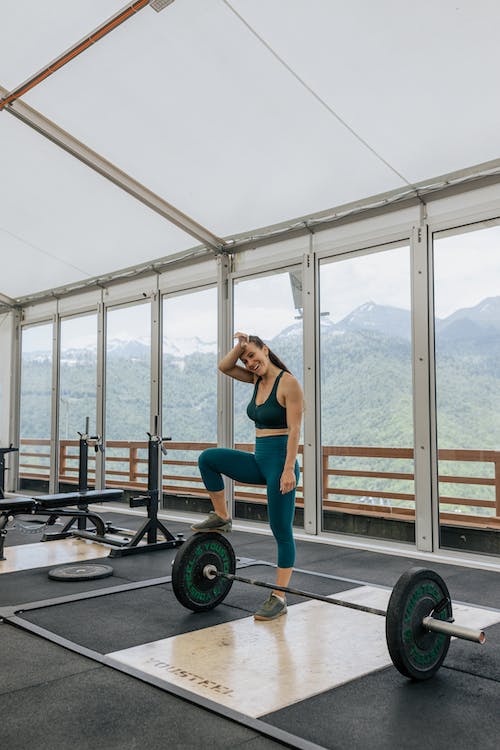
Safety bar squats are easier to load and unload than traditional barbell squats. This is because the safety bar does not have to be lifted over the head.
This can be helpful for people with limited mobility, such as older adults and people with injuries.
15. Versatile training tool
The safety bar can be used to perform a variety of exercises, such as rows, presses, and curls. This makes it a more versatile training tool than a traditional barbell.
For example, you can use a safety bar to perform a safety bar row, which is a variation of the bent-over row that is easier on the back. You can also use a safety bar to perform a safety bar overhead press, which is a variation of the overhead press that is easier on the shoulders.
Incorporating safety bar squats into your workout regimen offers an array of benefits, making them a valuable addition to achieve lower body strength, muscle development, and injury prevention. Always focus on proper form and consult a fitness professional to maximize the benefits and reduce the risk of injury.
Related Posts
Reference:
https://barbend.com/safety-squat-bar-benefits/
https://simplifaster.com/articles/safety-squat-bar-benefits/
https://garagegymlab.com/5-safety-squat-bar-benefits/
https://www.bodybuilding.com/content/6-reasons-to-train-with-a-safety-squat-bar.html
https://www.westside-barbell.com/blogs/the-blog/safety-bar-squats
https://pubmed.ncbi.nlm.nih.gov/32183616/
https://www.semanticscholar.org/paper/fa40da882cb54f11342bd3b77e9569edb07b529d
https://www.semanticscholar.org/paper/9cc5c731e975f8e422ed6d69356b1c5e4b6ef6a0


